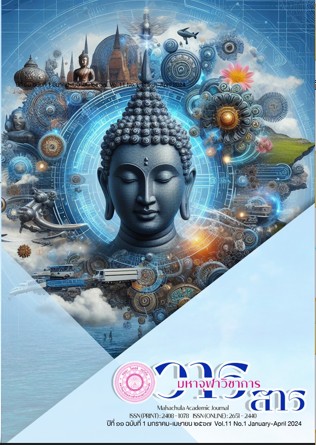An Analysis of Buddhist Principles that Appeared in Cakkavāladīpanī Scripture
Main Article Content
Abstract
Cakkavāladīpanī is an important buddhist scripture which was written in Pali language by Venerable Phra Sirimaṅgalācāriya, a Lanna philosopher, in B.E.2063 . This research article consists of 3 objectives, namely: - 1. to study the structure and content of the Cakkavāladīpanī; 2. to study the concept of the principles as appeared in the Cakkavāladīpanī; 3. to analyze the principles that appeared in the Cakkavāladīpanī. This is documentary research with the textual analysis and presenting in a descriptive form.
The findings showed that: Cakkavāḷadīpanī Scripture has 3 main parts, namely: - 1. Paṇāmagāthā is paying homage to the Triple Gem. 2. Among the 6 chapters, the content in each one has a separate topic depending on stories from the Tipitaka, Commentaries, Sub-commentaries, and Special Texts that mainly mention on the universe. 3. Pacchimagāthā, the latter part, is to emphasize the meaning of the Title, the background and the purposes of the composing, and the detailed history of Venerable Sirimaṅgalācāriya, the author. There are 3 principles that appeared in the Cakkavāḷadīpanī Scripture, namely: dāna, sīla, and kammaṭhānā. The practice of samatha meditation will result in the birth of next life in the world of Brahma. When one continues his practice with vipassanā, he is getting rid of all the worldly desires and his wisdom would be pure, and that is supposed to end the births or deaths of the human beings forever. As for the principles to be followed in everyday life in this Scripture, consisting of: giving (dāna), observing the precepts (sīla), and tranquil-insight meditation (samatha-vipassanā kammaṭṭhānā) for the ultimate fruit is Nibbāna. The Scripture represents the rise and fall of the worldly universe. The emergence of human beings in the first Aeon (kappa) as well as the existence of beings in the abyss, the human realm, the god realm, the way to avoid doing evil things, and the way to uphold the virtue in order to eventually attain to Nibbāna. It also suggests the danger and boredom of the rise and fall of the Universe, not for the sake of the obsession of worldly pleasure or enjoyment. The reason that Cakkavāladīpanī represents only these principles is because these principles are fundamental principles in Buddhism, which should be propagated and accessed. They are useful principles that conform to the context of the society of 2000 years after the enlightenment of the Lord Buddha.
Article Details

This work is licensed under a Creative Commons Attribution-NonCommercial-NoDerivatives 4.0 International License.
References
จำเนียร แก้วกู่. คัมภีร์ศัพทศาสตร์บาลี-สํสกฤต: ประวัติและความเป็นมาเน้นคัมภีร์ไวยากรณ์. กรุงเทพมหานคร: สำนักพิมพ์โอเดียนสโตร์, ๒๕๓๘.
ประพันธ์ ศุภษร. พระพุทธศาสนาเถรวาท. พระนครศรีอยุธยา: มหาวิทยาลัยมหาจุฬาลงกรณราชวิทยาลัย, ๒๕๖๔.
พระพรหมคุณาภรณ์ (ป. อ. ปยุตฺโต). พจนานุกรมพุทธศาสน์ ฉบับประมวลศัพท์. พิมพ์ครั้งที่ ๒๘.กรุงเทพมหานคร: สำนักพิมพ์ผลิธัมม์, ๒๕๔๙.
พระมหาปุณณจันทเถระ. โลกสัณฐานโชตรตนคัณฐี. ตรวจชำระโดย สำนักหอสมุดแห่งชาติ กรมศิลปากร. กรุงเทพมหานคร: รุ่งศิลป์การพิมพ์, ๒๕๔๓.
พระสิริมังคลาจารย์. จักรวาฬทีปนี. ตรวจชำระโดย สำนักหอสมุดแห่งชาติ กรมศิลปากร. พิมพ์ครั้งที่ ๒. กรุงเทพมหานคร: ศรีเมืองการพิมพ์, ๒๕๔๘.
มหาจุฬาลงกรณราชวิทยาลัย. พระไตรปิฎกภาษาไทย ฉบับมหาจุฬาลงกรณราชวิทยาลัยอังคุตตรนิกาย จตุกกนิบาต เล่มที่ ๒๑. กรุงเทพมหานคร: โรงพิมพ์มหาจุฬาลงกรณราชวิทยาลัย, ๒๕๓๙.
ศักดิ์ศรี แย้มนัดดา. วรรณคดีพุทธศาสนาพากย์ไทย. กรุงเทพมหานคร: คณะอักษรศาสตร์ จุฬาลงกรณ์มหาวิทยาลัย, ๒๕๔๓.
สดุภณ จังกาจิตต์. “จักกวาฬทีปนี กัณฑ์ที่ ๑, ๒, ๓”. วิทยานิพนธ์ปริญญาอักษรศาสตรมหาบัณฑิต. บัณฑิตวิทยาลัย. ภาควิชาภาษาตะวันออก, ๒๕๒๐.
สานุ มหัทธนาดุลย์. “พัฒนาการแนวคิดเรื่องปฐมธาตุของโลกและชีวิต: เหตุผลที่พุทธศาสนาปฏิเสธ”. สารนิพนธ์ปริญญาพุทธศาสตรดุษฎีบัณฑิต สาขาวิชาพระพุทธศาสนา. บัณฑิตวิทยาลัย: มหาวิทยาลัยมหาจุฬาลงกรณราชวิทยาลัย, ๒๕๕๕.
สุภาพรรณ ณ บางช้าง. ประวัติวรรณคดีบาลีในอินเดียและลังกา. กรุงเทพมหานคร: จุฬาลงกรณ์มหาวิทยาลัย, ๒๕๒๖.
แสง จันทร์งาม. อุทัย บุญเย็น. พระไตรปิฎกสำหรับผู้บวชใหม่และชาวพุทธทั่วไป. พิมพ์ครั้งที่ ๕.กรุงเทพมหานคร: สำนักพิมพ์ศยาม, ๒๕๕๖.


